 | |
| Alternative names | Mezze |
|---|---|
| Variations | Numerous |
Meze (also spelled mezze or mezé) (/ˈmɛzeɪ/, /ˈmɛzɛ/) is a selection of small dishes served as appetizers in Albanian, Bosnian, Armenian, Kurdish, Levantine, Turkish, Bulgarian, Greek, Iraqi, Egyptian, Balkan, Caucasian and Persian cuisine, to name a few.[1][2] It is similar to Spanish tapas and Italian antipasti.[3] A mezze may be served as a part of a multi-course meal or form a meal in itself. In non-Islamic countries, or in areas without alcohol restrictions, mezze are often served with spirits such as arak, raki or grappa.
Etymology
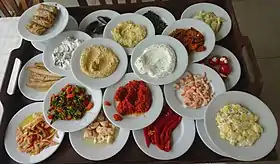
The word meze is found in all the cuisines of the former Ottoman Empire, borrowed from Turkish, which in turn had borrowed it from the Persian mazzeh or mazzah (مَزّه) 'taste' or 'relish'.[4]
Common dishes
In Turkey, meze often consist of beyaz peynir (literally "white cheese"), kavun (sliced ripe melon),[2] acılı ezme (hot pepper paste often with walnuts), haydari (thick strained yogurt with herbs), patlıcan salatası (cold eggplant salad), beyin salatası (brain salad), kalamar tava (fried calamari or squid), midye dolma and midye tava (stuffed or fried mussels), enginar (artichokes), cacık (yogurt with cucumber and garlic), pilaki (foods cooked in a special sauce), dolma or sarma (rice-stuffed vine leaves or other stuffed vegetables, such as bell peppers), Arnavut ciğeri (a liver dish, served cold), octopus salad, and çiğ köfte (raw meatballs with bulgur). A selection of mezes can be served as appetizers in a multi-course dinner, or as snacks accompanying drinks such as rakı.
In Greece, Cyprus, Bulgaria and the rest of the Balkans mezé, mezés or mezédhes (plural) are small dishes, hot or cold, spicy or savory. Seafood dishes such as grilled octopus may be included, along with salads, sliced hard-boiled eggs, garlic bread, kalamata olives, fava spread, fried vegetables, melitzanosalata (eggplant salad), taramosalata, fried or grilled cheeses called saganaki, and sheep, goat, or cow cheeses.



Popular meze dishes include the following.
| Arabic | Greek | Turkish | Armenian | Image | Description |
|---|---|---|---|---|---|
| Arayes
lahmacun(pronounced lahm biajeen) |
Lahmacun | Lahmajoun, misahats | Barbecued flatbread filled with lamb meat, onions, tomatoes and spices | ||
| Asbe sawda | Sykotákia | Arnavut ciğeri |  |
A liver dish | |
| Baba ghanoush (Moutabal) |
Melitzanosaláta | Patlıcan ezmesi (Babagannuş) |
Mutabal | 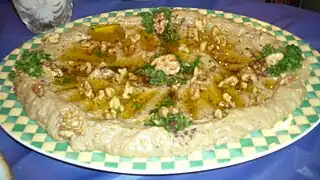 |
Mashed eggplant (aubergine) |
| Burek | Bouréki | Börek | Boureg |  |
Phyllo/yufka-based filled pastries |
| Wara Enab | Dolmathákia | Sarma (Yaprak sarma) Dolma |
Sarma |  |
Leaves (mostly grape leaves) rolled around rice-based filling |
| Falafel | Revithokeftédes | Falafel/Felafel | Baklayov kyufta | 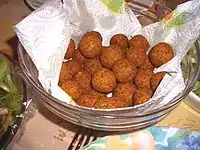 |
A deep-fried ball or patty made from ground chickpeas, fava beans, or both |
| Fasuliya | Gigantes plaki | Fasulye pilaki | Fasoulia |  |
|
| Fattoush | Fettuş | 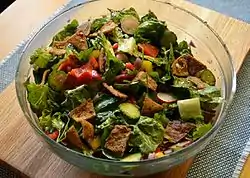 |
Salad of vegetables and toasted or fried pieces of pita bread | ||
| Fáva Santorínis |  |
Lathyrus clymenum seeds boiled and mashed into paste, with olive oil and chopped onion | |||
| Ful (Mdammas) | Koukiá | Bakla ezmesi (Fava) |
Fava beans mixed with seasonings | ||
| Hummus | Hoúmous | Humus | Homus | 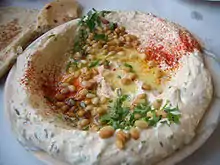 |
A dip or spread made from cooked, mashed chickpeas |
| Kalamarákia tiganitá | Kalamar tava | Fried squid (calamari) | |||
| Khyar Bi Laban | Tzatziki | Cacık (read:jah-juck; soupy or dry variations), Haydari(dry; no cucumber and strained yoghurt) | Jajik | Cucumber, yogurt, herbs (mostly mint), seasonings(garlic optional), served thick as a dip in Greece and thin like a cold soup in Turkey and Arabic countries | |
| Kibbeh | Koúpes | İçli köfte | Ishli Kyufta | 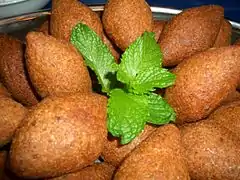 |
Meatballs made of bulghur, chopped meat, filled with meat, pine nuts and spices |
| Kafta(Kofta) | Keftédes | Köfte | Kufteh | Meatballs made of chopped meat, onion, parsley, and spices | |
| Şiş köfte | Kebab-style köfte | ||||
| Kibbeh nayyeh | Çiğ köfte | Chi Kufte, Hoom Kufteh |  |
Raw meat dish | |
| Tabbouli | Kısır | Eech | 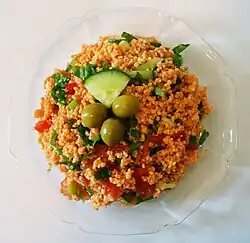 |
Bulgur salad with finely ground parsley, and tomato paste | |
| Kolokythoanthoí gemistoí | Kabak çiçeği dolması |  |
Stuffed squash blossom | ||
| Labaneh | Labne
Süzme Yoğurt |
Lebni |  |
Yoghurt that has been strained to remove most of its whey, resulting in a thicker consistency than unstrained yoghurt
(Seasoning such as garlic and herbs are sometimes added) | |
| Ljit kousa | Kolokythokeftédes | Mücver | .jpg.webp) |
Zucchini fritters | |
| Maintanosaláta | Dip made from finely chopped parsley mixed with olive oil, vinegar, lemon juice, garlic and a base of either bread or potatoes | ||||
| Muhammara | Cevizli Acılı Ezme (Acuka) |
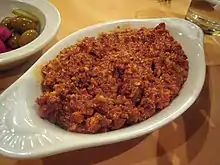 |
A hot pepper dip with ground walnuts, breadcrumbs, garlic, salt, lemon juice, and olive oil | ||
| Piyaz | 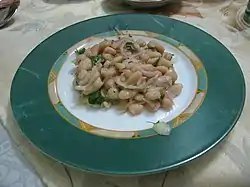 |
Salad made from any kind of dry beans with onion, parsley and sumac | |||
| Salatit Roka | Róka Saláta | Roka | Rocket salad | ||
| Şakşuka | .jpg.webp) |
Vegetables cooked in olive oil | |||
| Sikh lahme (for lamb or beef), Shish taouk (for chicken) | Souvlaki | Şiş tavuk Çöp şiş |
Shish kebab, Khorovats |  |
Bite sized meat cubes (lamb is very common), grilled on a skewer over charcoal |
| Sujuk | Soutzoúki | Sucuk | Sojoukh | .jpg.webp) |
Dry, spicy sausage |
| Tabbouleh | Tabbule or Arap salatası | Tabuleh |  |
Bulgur, finely chopped parsley, mint, tomato, spring onion, with lemon juice, olive oil and seasonings | |
| Taramosalata | Tarama | 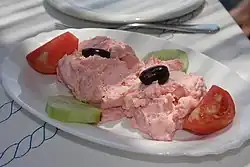 |
Dip made from tarama, the salted and cured roe of the cod, carp, or grey mullet (bottarga) mixed with olive oil, lemon juice and a starchy base of bread or potatoes or sometimes almonds | ||
| Tajin | Dip made of fish and Tarator (Tahini and lemon) | ||||
| Gemistá | Dolma | Dolma |  |
Peppers, eggplants, or courgettes stuffed with rice and meat | |
Other meze dishes include cheeses (such as halloumi, labneh, tulum, or shanklish) or meat dishes (like afelia, lountza, or pastirma), fish (like fried whitebait, calamari).
In Greece, meze is commonly served as a plate of snacks to accompany drinks such as ouzo and tsipouro.
In Israel, Palestine, Jordan, Syria, Lebanon, and Cyprus, meze is often a meal in its own right. There are vegetarian, meat or fish mezes. Groups of dishes arrive at the table about four or five at a time (usually between five and ten groups). There is a set pattern to the dishes: typically olives, tahini, salad, and yogurt will be followed by dishes with vegetables and eggs, then small meat or fish dishes alongside special accompaniments, and finally more substantial dishes such as whole fish or meat stews and grills. Establishments will offer their own specialties, but the pattern remains the same. Naturally the dishes served will reflect the seasons. For example, in late autumn, snails will be prominent. As so much food is offered, it is not expected that every dish be finished, but rather shared at will and served at ease.
In the Balkans, meze is very similar to an Italian antipasto in that cured cold-cuts, cheese and salads are dominant and cooked foods are not included. In Serbia, Croatia, Bosnia, and Montenegro it includes hard or creamy cheeses, kajmak (clotted cream) or smetana cream, salami, ham and other forms of suho/suvo meso (cured pork or beef), kulen (paprika flavoured, cured sausage), cured bacon, ajvar, and various savory pastries. For Muslims, meze replaces pork products with sudžuk (dry, spicy sausage) and the pastirma-like cured beef suho meso. In southern Croatia, Herzegovina, and Montenegro, cured meat such as pršut and panceta and regional products like olives are common. Albanian-style meze platters typically include prosciutto ham, salami, and brined cheese, accompanied with roasted bell peppers (capsicum) or green olives marinated in olive oil with garlic. In Bulgaria, popular mezes are lukanka (a spicy sausage), soujouk (a dry and spicy sausage) and sirene (a white brine cheese). The Bulgarian-made shopska salad is also a very popular meze. It is made with tomatoes, cucumbers, onion, peppers, and sirene. Ajvar and pindjur are popular mezes in North Macedonia. In Romania, mezelic means a quick appetizer and includes zacuscă, cheeses, and salamis, often accompanied by tuică.
Alcoholic accompaniment
Depending on the region, meze can be served with alcohol. In the Middle East, most people will opt for arak or ouzo. In the Balkans, meze are generally accompanied by the distilled drinks rakı, arak, ouzo, Aragh Sagi, rakia, mastika, or tsipouro. It may also be consumed with beer, wine and other alcoholic drinks. Cyprus brandy (served neat) is a favourite drink to accompany meze in Cyprus, although lager or wine are popular with some.
Serving traditions
In Bulgaria, meze is served primarily at the consumption of wine, rakia, and mastika, but also accompanying other alcoholic drinks that are not local to the region. In addition to traditional local foods, meze can include nuts, sweets, or pre-packaged snacks. The term meze is generally applied to any foods and snacks consumed alongside an alcoholic beverage. In Greece, meze is served in restaurants called mezedopoleíon and tsipourádiko or ouzerí, a type of café that serves ouzo or tsipouro. A tavérna (tavern) or estiatório (restaurant) offer a mezé as an orektikó (appetiser). Many restaurants offer their house poikilía ("variety")—a platter with a smorgasbord of mezédhes that can be served immediately to customers looking for a quick or light meal. Hosts commonly serve mezédhes to their guests at informal or impromptu get-togethers, as they are easy to prepare on short notice. Krasomezédhes (literally "wine-meze") is a meze that goes well with wine; ouzomezédhes are meze that goes with ouzo.
See also
References
- ↑ Davidson, Alan (21 August 2014). The Oxford Companion to Food. Oxford University Press. pp. 517–518. ISBN 9780191040726 – via Google Books.
- 1 2 Arditi, Talya (29 December 2015). "How to drink raki: A crash course in Turkey's signature drink". CNN Travel. CNN. Retrieved 18 June 2019.
- ↑ Weir, Joanne. From Tapas to Meze: Small Plates from the Mediterranean. United States, Ten Speed Press, 2004.
- ↑ Speake, Jennifer; LaFlaur, Mark, eds. (1999). "Meze". The Oxford Essential Dictionary of Foreign Terms in English. Oxford University Press. Retrieved 13 December 2020.
{{cite book}}:|website=ignored (help)
Bibliography
- Wright, Clifford A. (2001). Mediterranean vegetables: a cook's ABC of vegetables and their preparation in Spain, France, Italy, Greece, Turkey, the Middle East, and north Africa with more than 200 authentic recipes for the home cook (Illustrated ed.). Harvard Common Press. ISBN 9781558321960.
